46 years in Computing, 1945-1991
Margaret (Kampschaefer) Butler was a pioneer in technology, a ground-breaking woman who graduated with a B.S in Mathematics and Statistics in 1944, and followed a fascinating career path in the public sector starting in the earliest days of computers and nuclear energy. One of the early female “computers,” she worked on the first atomic submarine. She also spent time overseas after WW II as an employee of the U.S. military. At Argonne National Laboratory, where she spent many years, Margaret worked with the AVIDAC, ORACLE, GEORGE, UNIVAC, and more, in the formative days of computing. Her experience spanned a technical management track in public service, as Director of the National Energy Software Center, which does R&D for a spectrum of Atomic Energy Commission issues. Margaret was the first woman Fellow at the American Nuclear Society, and is an Honorary Lifetime Member. Margaret draws on decades of success as well as setbacks, to provide a perspective on computer technology and women technologists. This is a story, for all scientists, that deserves to be told… and a celebration of her life, which passed on March 8, 2013…
The Formative Years: 1924 – 1945
Margaret herself has commented: “My route has not been a typical role model track you would choose to follow if you could, and of course you can’t, since we’re all creatures of the society of our time, and much has changed over the past four decades.” But, her life was in a time of excitement and transformation, so let’s start at the beginning.
Childhood
Margaret Kampschaefer was born March 27, 1924 and grew up mostly in Evansville, Indiana, with a few years — the junior high ones –spent in Erie, Pennsylvania. She was the second of three girls in a family unit composed of Otto and Lou Etta Kampschaefer: a Mechanical Engineer graduate of Purdue University, Boy Scout leader, bread-winner; a homemaker, Girl Scout leader, mother; and a caregiver grandmother. It was pretty traditional for that time, except that her mother, who was a business school graduate and had been employed as a bookkeeper before her sister was born, continued throughout her lifetime to participate in the activities of a business women’s club, and spent some of her summers filling in for club members while they took their vacations. Her mother’s career as a bookkeeper flourished while her father served overseas during World War I, but terminated with his return and the birth of a child.
University and Self-Direction
It was always understood that all the children would attend college, so upon graduation Margaret left home for college with a State Scholarship to Indiana University, unsure what she wanted to be or study. She thought perhaps a social service worker to help people. In Bloomington she enrolled in the required English and foreign language classes and first-year sociology and psychology courses, which left her frustrated. She says, “My educational experience did not seem worth my parent’s sacrifice in sending me, and my younger sister was due her college education upon her graduation. “
Margaret comments, “My frustration was that of an analytical mind. On tests, there were no correct answers; if you wrote long enough and rationally enough any answer seemed as good as any other. I did enjoy the statistics in the psychology laboratory courses. Feeling I was on the wrong path, I asked to take the aptitude tests offered by the Psychology Department. First, I took those for women. They provided no real answer. I did learn that I probably should not entertain the notion of becoming a professional musician, but then my grade school music teacher had already made me aware of my lack of talent in this area. Failing to learn anything from the women’s tests, at the counselor’s suggestion I took those for men with similar results. Whereupon I concluded that it was really up to me to decide just what it was I wanted to do with my life…no test was going to supply the answer!”
The Turning Point: The origins of interest in computers, rethinking the BS
Margaret says, “I became dissatisfied with my social science courses when on the examinations it seemed any answer that could be supported by a reasoned paragraph or two was as correct as any other. What was I really learning? I did enjoy the statistics offered in the psychology laboratory course and decided I’d like to take more courses in this field. I enrolled in Mathematical Statistics and Differential Calculus in the Mathematics Department.”
“For me, this was the turning point. I found my math courses difficult requiring long hours of study but there was always the satisfaction of learning and the thrill of getting the correct answer!”
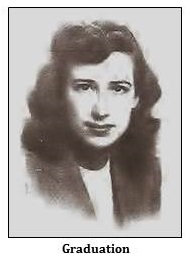
An early iconoclast! Her energy would be needed throughout her career….
Prelude to Computing 1945-1948
Statistician with Bureau of Labor Statistics 1945
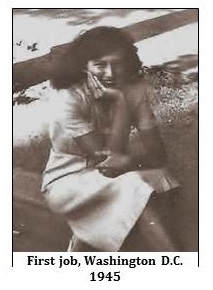
Upon completion of her Bachelor’s degree in 1944, in Mathematics and Statistics, she took a Civil Service examination and obtained a job as a Statistician with the Bureau of Labor Statistics in Washington, DC.
It was thrilling in the nation’s capitol; her job was challenging, and her boss was supportive. He gave her the opportunity to substitute teach in mathematics courses at the U.S. Department of Agriculture Graduate School, and she enrolled in graduate courses in sampling theory being taught by pioneers in the field.
U.S. Air Force Statistician in Europe 1946-1948
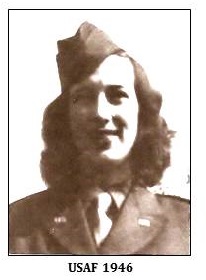
After being with the Bureau for a little more than a year and learning a lot, Margaret heard from a colleague of an opportunity for statisticians willing to work in Europe with the Air Force, and jumped at the chance. She was brought on board as a civilian contract employee in the General Services Administration.
Margaret was stationed in Germany (this was right after WWII) in Erlangen and Wiesbaden, and traveled widely in this phase of her early career. Margaret believes in taking calculated career risks, and recommends it to other women in technology. Work adventure, and trying out new opportunities, helps in exploration of your own traits, capabilities, preferences and values.
Argonne National Labs (ANL) 1948-1949
Upon her return from Europe, two years later, she came to Chicago to seek employment. Her qualifications at the time were a B.S. in Mathematics and Statistics from Indiana University, graduate work in Sampling Theory at the V.S.D.A. Graduate School in Washington, D.C. and three years of experience as a Statistician with the U.S. Bureau of Labor Statistics in the nation’s capitol and the US Air Force in Europe.
Breaking In
After a few interviews, tests, and one offer not hard to refuse, she was about ready to give up when she learned the University of Chicago was hiring for the DuPage site of the new Argonne National Laboratory (ANL), recently approved as the Midwest’s center for atomic research and development. The Laboratory was organized in 1947 as a successor to the Metallurgical Laboratory, to be operated by the University for the Atomic Energy Commission.
She went to Argonne National Lab’s employment office at the Museum of Science and Industry and completed the necessary application, turned in her resume with a copy of her college transcript, and talked with a member of their Personnel staff.
But, the Laboratory’s Personnel office held out little hope, since she lacked a Ph.D. in Mathematics.
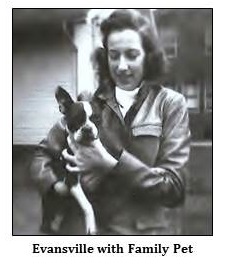
Then, back home in August, she received a call from Joe Dietrich, Reactor Physicist leader of a group being relocated from Oak Ridge to form the new Laboratory’s Naval Reactor Division and design the prototype for the Navy’s nuclear submarine reactor. He offered a job as a JuniorMathematician (!) with the Laboratory’s Naval Reactors Division staff as soon as clearance could be arranged.
Not long after, her mother wrote that the next-door neighbor had come over to tell her an FBI officer had been to see her asking questions about Margaret. The neighbor reported she had told him, “Just go next door and ask her folks, they can tell you whatever you need to know.”
In Chicago, she went through the mandatory physical examination, where she met another new employee, Adolph Toepfer, who had been selected from Westinghouse’s East Pittsburgh Works to work on what he said was the Division’s mission – the design, development and engineering of a water-cooled submarine thermal reactor (STR).
New Beginnings, in Old Buildings
At the time, there were station wagon shuttles, running between the University and Site A, the Argonne Forest Preserve location where the current Argonne Laboratory was located, along with a cafeteria, parking space, and dormitory for staff that were there overnight. ANL work at the time was being carried out at some 13 different former Met Lab sites dating from the Manhattan Project. Among them were a Site B, a refurbished brewery that housed biological and metallurgical research efforts, and a Site C, New Chern, where chemical research was being conducted. So, the newly acquired Du Page site which originally consisted of the Freund Estate and some 148 small farms became known as Site D, the home of today’s Argonne National Laboratory.
Site D at the time consisted of four Quonset huts, still undergoing construction, located on an elevated clearing with adjacent parking just west of a sea of mud, in the center of which was a small telephone shack, identifiable by the lines and poles surrounding it. This was to be the East Area, and the permanent brick buildings to house the Physics, Biology, Chemistry, Chemical Engineering, Metallurgy, and Reactor Divisions were scheduled for construction in what would be known as the West Area. The Laboratory address was a P.O. Box in Chicago.
But it was all about the people, the talent….Margaret says, she shall never forget her first visit to the Laboratory, when escorted by the Personnel Director, and treated to lunch at Site A with two of the Laboratory’s Division Directors (one of whom was Frank Hoyt, Physics). “I was impressed!”
An interesting aspect of those first Quonset hut days was that when the first ones had no women’s restrooms. Dr. Zinn had estimated that the number of women would be so small that while each building of necessity included a men’s restroom; a women’s restroom was to be provided only in every fourth building. Therefore, when she first arrived there was a neatly lettered sign posted on one of the Men’s restrooms labeled “WOMEN”. This at times caused embarrassing situations. In the beginning there were just two women staff members in the division, Deckie Rice, a Junior Chemist who was transferred from Oak Ridge, and herself.
A Female “Computer”
Her job was technically a “Junior” Mathematician at the Laboratory’s Naval Reactors Division staff, but in reality was it was to be a “computer.”
In those days a “computer” was an individual who performed the mathematical and numerical computations required to solve mathematical physics and engineering problems using generally available tools such as slide rules, tables of integrals and special functions, and any of the various electromechanical calculators on the market.
For the first few days an extremely long slide rule served, until the specially ordered electromechanical calculators (Monroe, Friden and Marchant with additional columns) arrived from the manufacturers. The WPA tables of functions, the British Association Tables of Bessel Functions, and standard tables of integrals and special functions were soon available from a library hastily assembled by a former Cicero Public Library librarian.
Under the direction of the more senior mathematicians, physicists, and engineers, Margaret was kept busy solving eigenvalue problems by inversion of large matrices to determine the critical mass of different reactor configurations, applying relaxation methods to partial differential equation control rod studies, and finding the necessary Bessel function, logarithmic, and trigonometric values to produce graphs of calculated neutron flux and source distributions.
- To ensure accuracy, it was necessary to repeat the calculations at least once to check the results, a tedious task.
- In addition, for security purposes, the calculations were recorded in special notebooks and stored in office safes locked at the end of the day.
Margaret worked there for about a year as a ‘computer,’ for the physicists who were designing the prototype submarine reactor. She also attended on-site Atomic Physics and Reactor Design courses to increase her knowledge of this new field, acquiring an education in atomic physics and nuclear engineering through courses and assignments.
In 1949, the National Reactor Testing Station was established in southeastern Idaho, part of a former Naval Proving Ground serving the Pocatello Ordnance Depot. Many of the NR staff interested in fishing, hunting, and other outdoor activities then transferred to this Argonne-West location where construction of the Experimental Breeder Reactor (EBR) was begun and engineering work on the STR prototype was done.
While she enjoyed her work and the academic atmosphere of the Laboratory, she perceived that her future seemed bleak as a woman without a Ph.D., preferably in Physics.
For a woman at ANL, progress seemed hard even with the right technical qualifications and impossible without having advanced degrees. So, Margaret started to evaluate other options.
(What she hadn’t counted on was the fact that among her colleagues from Oak Ridge was a Mathematician whom she would marry two years later…!)
Bureau of Labor Statistics, 1949-1951
Perceiving that her future was limited as a woman, without a PH.D., when asked by the Bureau of Labor Statistics to direct a special joint Minnesota-US project, she resigned and chose to move to St. Paul, Minnesota, feeling the lack of a strong physics background was a drawback to further advancement at Argonne.
Subsequently, Margaret was scheduled to return to Washington, D.C. to work for the Bureau in Washington DC, but personal matters intervened. On the cusp, combining work and love, she changed direction and decided instead to return to Argonne in 1951 to marry a great guy, Jim Butler, a brilliant mathematician whom she felt was the only man for her. Margaret often said Jim was “the most intelligent man that I ever met!”
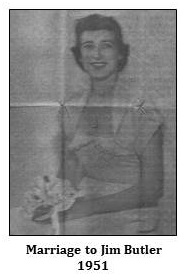
So, for both professional and personal reasons, Margaret returned to Argonne in 1951 upon completion of the special project.
Margaret and Jim’s son, Jay W. Butler, was born May 27, 1954. Jay earned his B.S. in civil engineering from IIT and an MBA in real estate from DePaul University. Jay has helped transform Chicago’s skyline with his tall-building construction management contributions.
Return to Argonne Labs: 1951-1972
Career Excitement at Argonne 1951
In 1951, Margaret became an Assistant Mathematician in the Reactor Engineering Division, a combination of the former Naval Reactor Division and Dr. Zinn’s Reactor Engineering and Services Division.
She comments, ironically or not, “At that time, thankfully, the Laboratory had eliminated the Junior Mathematician title; I became an Assistant Mathematician.”
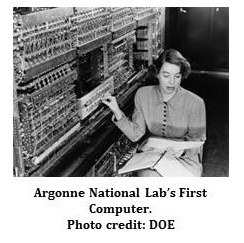
More importantly, the Laboratory had obtained Atomic Energy Commission funding for construction of a digital computer, or “electronic brain,” in the parlance of the day, to put at its disposal “the most modern means of scientific computation.”
“Moll” Flanders, Senior Mathematician in the Physics Division, and head of the Division’s Mathematics Group, was the director of the project and Jeffrey Chu was the Chief Engineer. The ANL computer and another at Los Alamos Scientific Laboratory were to be based upon a prototype being constructed simultaneously at the Institute for Advanced Study in Princeton.
This was in 1951 prior to commercially available computers, and Margaret was in the right place at the right time…and with the right attitude!
Margaret asked to work with Dr. Flander’s group on the AVIDAC computer project with the intent of utilizing the machine for reactor computations.
The AVIDAC 1949-1953
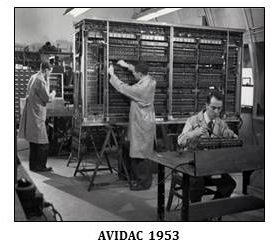
The Argonne machine, christened AVIDAC for Argonne’s Version of the Institute’s Digital Arithmetic Computer, was under development from 1949 to 1953, when it began operation.
Margaret’s first programming assignment was to write the interpretive floating-point arithmetic system for the Argonne AVIDAC:
- It consisted of a binary fixed-point Arithmetic Unit, a Control Unit, a Williams cathode-ray tube Memory Unit designed to store 1024 40-bit words, and modified Teletype paper tape input/output units.
- Modified teletype stations were utilized as paper tape preparation and printer stations.
- Memory access time was 15 microseconds; additions were performed in 10 microseconds, and multiplication required a millisecond.
- In announcing the AVIDAC’s completion, it was stated that the machine was approximately 100,000 times as fast as a trained computer using a desk calculator.
- More importantly, once a program was written to solve a problem and debugged, multiple problems of that kind could be solved with no need for repeated calculations.
- The arithmetic unit was 10 x 2-1/2 x 7 feet in size; and the memory unit 14 x 2-1/2x 4-1/2 feet in size; not your modern laptop!
The tasks of preparing the engineering test and maintenance routines and programming the decimal-to-binary and binary-to -decimal conversions for input and output, 8 mathematical subroutine library, and floating-point interpretive systems kept both the Laboratory’s computing groups busy. As soon as possible, the AVIDAC was put to work on reactor problems.
- The first reactor program written was the solution of the three – region spherical reactor “critical” problem, known as RE-l.
- This was followed by RE – 4, RE-5, and RE-5, the bread-and-butter diffusion theory calculations for sphere, slab, and cylindrical geometries.
The hardware performed all arithmetic operations under the assumption that the operands were represented in the range between -1 and 1. This meant that it was necessary in designing a computer program to scale operands and operations to ensure all operands and results remained in this range throughout the computation! (Talk about user-friendly……we’ve come a long way, baby!)
Although floating-point interpretive routines were available (Margaret’s first programming Job was to write one for use prior to implementation of the register overflow bit), they generally consumed too much storage and time except for the most trivial problems.
- In their discussion of whether or not floating-point hardware should be built into a machine, Goldstine and von Neumann argued, “Besides the floating binary-point represents an effort to render a thorough mathematical understanding of at least a part of the problem unnecessary, and we feel that this is a step in a doubtful direction.”
There is no doubt that the error analysis inherent in the preparation of these early scaled applications is rarely attained in the preparation of today’s programs. Margaret says, “It is interesting to look back, at some of the characteristics of this early computing environment. Although it was necessary, due to problems with the electrostatic memory, to reduce the design 1024 – word memory to 256 words, these programs made use of an operating system of sorts, including a relocatable program loader, input and output conversion routines, and a correction and check-sum facility. Dynamic storage allocation was attempted, albeit with the assistance of manually calculated pointers read in as part of the problem input, and the programs themselves were executed from a chain or overlay tape constructed by liberal application of DUCO cement and use of a tape-splicing device. Being circular, however, it did eliminate the rewind delay.”
She learned, then taught, computer architecture and programming before there were courses available in any schools on the subjects, since university computer science courses had not yet arrived.
Margaret says, “It was the best of times!”
She was a member of the logical design team for the second ANL computer, GEORGE, and wrote mathematical subroutines, systems software, reactor applications, and utilities for the three Argonne-built computers – AVIDAC 1943-1953, ORACLE, 1950-1953, GEORGE, 1955-1956 – and the first commercially-available machine, the UNIVAC 1954-1958, which was installed at the AEC’s New York University Computing Facility for contractors’ use.
The ORACLE 1950-1953
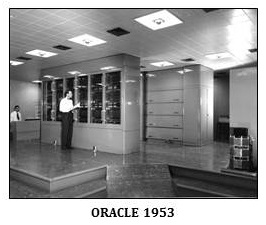
From 1950, in parallel with the engineering development and construction of the AVIDAC, ANL and Oak Ridge National Laboratory (ORNL) engineers collaborated on the construction of a second computer for use at ORNL, the ORACLE. The time-lag between the construction of the Argonne and OakRidge machines was sufficient to avoid the pitfalls and incorporate improvements suggested by AVIDAC experience.
- Arithmetic times were improved.
- In an attempt to alleviate the memory problems the Memory Unit was composed of 80 rather than 40 cathode-ray tubes of a different type. They were packaged two per unit and designed to check one another or, if proved reliable, to operate independently as a 2048-word memory. Extra units were kept warm as spares for additional redundancy.
An Argonne press release in September 1953 announced completion of “the world’s fastest high-speed general-purpose digital computer… with the greatest capacity of any yet built.”
The ORACLE fulfilled all the AVIDAC’s promises, and in the final days before its shipment to Oak Ridge in the fall of 1953 there was a mad but unsuccessful crash program to run at least one Argonne reactor problem before turning the machine over to ORNL. Not long afterward, however, the Laboratory was awarded an allocation of machine time on the UNIVAC at the AEC Computing Facility operated by New York University. This machine, the fourth model of the first electronic computer produced for the commercial market, was purchased by the AEC for use on atomic energy programs and Joint AEC-Office of Naval Research contracts. Bids for machine time were accepted and scheduled by the AEC Computer Council.
The UNIVAC 1954-1958
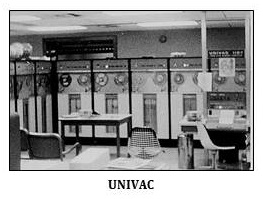
The UNIVAC (first delivered commercially in 1951) was a fixed-point decimal machine with a 1000-word mercury delay line memory and magnetic tape input/output and auxiliary storage.
- Duplicate arithmetic circuits provided automatic checking of calculations.
- Its reliable performance together with its large secondary tape storage made it attractive for reactor physics programs.
One-dimensional programs for all three geometries were prepared for an initial debugging expedition to New York City in early 1954, made by Margaret and her team.
From then until 1958, thousands of reactor design problems were solved on the UNIVAC. The April 1954 Reactor Development Quarterly Report describes UNIVAC solutions to problems such as the plutonium loading of the experimental EBR-I reactor, and the effect of changes in composition on the reactivity of its successor EBR – II.
In the same report, an announcement tells of the Laboratory decision to purchase one of four 4096-word magnetic core memories built by Telemeter Magnetics to upgrade the AVIDAC.
It didn’t take much imagination to figure out that what was needed was not a new memory for an old machine, but instead a new machine to go with the new memory — and GEORGE was conceived!
Margaret served with Dr. Flanders until November 1955. During this period she developed a Laboratory Applications Program Library and established the U5AEC reactor code center as an extension of that library. This center, known as the Argonne Code Center, was created in response to a proposal made by the Mathematics and Computation Division of the American Nuclear Society for a central information agency and depository for computer programs of common interest.
The GEORGE 1955-1957
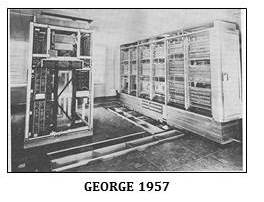
During 1955 and into 1956, Margaret worked with the group on the design of GEORGE, which evolved from lessons learned during the construction and development of the AVIDAC and ORACLE, as well as the experience gained on the UNIVAC.
Still, through 1956 and into 1957 while GEORGE was under construction, the AVIDAC was kept busy on reactor applications such as the solution of the reactor kinetics equations, the inverse problem of determining the time-dependent reactivity consistent with a measured time-dependent neutron flux distribution, statistical studies of neutron penetration in water, transfer function analysis, least squares fitting, and spherical harmonics calculations.
Most of the kinetics programs were developed originally to investigate the oscillatory behavior of EBR-I and to analyze the data obtained from the BORAX reactor experiments at the Idaho site.
Margaret says that Argonne’s first data transmission application probably occurred when the Laboratory’s commercial teletype stations were used to transmit the neutron flux data from the Idaho site for input to AVIDAC programs.
GEORGE’s name was chosen as much in protest to the proliferation of AC machines – MANIAC, ORDVAC, ILLIAC – as in sympathy for the slang of the day, such as “Real GEORGE” and “Let GEORGE do it.”
This computer, like the Institute-sired machines, had a 40-bit word, represented as ten hexadecimal characters. It had a two-address code which could be used to give the effect of a three-address code and yet retained many of the desirable features of the one-address code. The second address could be designated as the address of an index register, a preliminary addend, an operand store address, or a Jump or branch address. Half-precision multiply and divide instructions were incorporated specifically for use in statistical calculations.
GEORGE components included, in addition to the paper tape input/output, a console typewriter and input keyboard , the wide magnetic tape auxiliary memory originally developed for the AVIDAC, a magnetic tape output facility, a plotter, and a cathode-ray tube display and film recorder.
The IBM 704: 1957
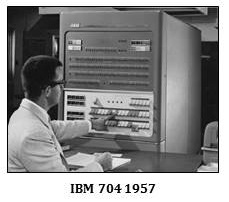
Meanwhile, computational requirements of the reactor program continued to grow, and funding was obtained to meet the increased demand. After an evaluation of the scientific computers on the market – the Remington Rand ERA 1103A and the IBM704 (introduced in 1954) – an IBM704 was purchased, with delivery promised for late 1957.
The IBM704 machine as delivered consisted of the central processing unit, an 8192-word core memory with a 12 microsecond access time, 8192-word magnetic drum auxiliary storage, attached card reader, card punch and printer, nine magnetic tape units, and independent card-to-tape and tape-to-card off-line facilities. An important new feature was the incorporation of floating point arithmetic hardware.
Additional personnel were hired for the Reactor Computing Group, and Margaret was named Group Leader and given the responsibility for teaching computer programming.
New problems and a few old ones, such as the reactor shield design program, RE-34, which had been too large to tackle on the AVIDAC, were written for the IBM704 in assembly language prior to IBM’s introduction of the initial version of the FORTRAN compiler.
From 1958 on FORTRAN was used on the IBM704 whenever possible in preparing reactor applications. There were two limiting factors, however: the size of the memory and the versatility of this first FORTRAN.
- Because of these, the Laboratory’s multi-group programs were written in assembly language.
- It was not until 1950 when the magnetic core storage was increased to 32,758 words and the more flexible FORTRAN II compiler with subroutine capability became available that the larger, more complex reactor design and engineering applications became amenable to higher-level language.
In April of 1959 the Reactor Computing Group was combined with the newly created Applied Mathematics Division in a Laboratory reorganization to centralize scientific computing.
As Head of the new Division’s Applications Programming Section, Margaret was responsible for developing programming groups for Reactor, Physics, Chemistry, Biology, High Energy Physics, and Management Applications problems and coordinating the work of these groups with the research activities of individual members of the Division’s Consultation and Research section.
OOPS O/S for the IBM704
Margaret and her team helped to implement the first computer operating system employed at Argonne, OOPS, for the IBM704. The basic requirement was that it have minimum impact on the existing user-program environment.
- It was designed to reside completely on the 704 drum, if necessary.
- The core resident could be flushed as required when the user job demanded full-core facility, and brought in by operator intervention in the event such full-core jobs aborted.
- An IBM1401 served as a support processor preparing the system input tapes and printing and punching OOPS output tapes.
- This tape-oriented system helped delay the saturation point for the 704, and use of the IBM system continued through fiscal 1955, almost three years after the CDC3500 installation.
CDC3600: 1963
Two computer system evaluations and acquisitions were dictated by the need for additional computing capacity, the first in 1963 with the addition of a CDC3600; and the second over the 1964 to 1965 time period, resulting in the procurement of an IBM360 system.
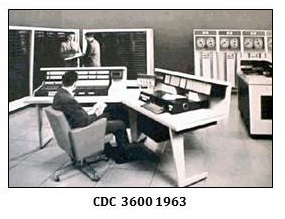
The CDC configuration purchased included the central computer, a 65,536 word magnetic core memory, 16 magnetic tope units, a satellite and an off-line 160A computer with four magnetic tape units, four printers, two card readers and two punches, a 4-million word disk file auxiliary memory, and a DD80 display unit equipped with a 35mm camera for film recording. In addition, two remote 160A stations with card and tape facilities were set up, one in the High Energy Physics building, the other in the Reactor Engineering building.
Significant features of this machine were its 48-bit word length, the 65,536 word fast memory which was double the 704s’, the film output available previously only on GEORGE, and the disk file unit.
When the CDC3600 was delivered, a subroutine library accompanied the machine, but there was no documentation. A project was immediately undertaken to test and document the vendor-supplied software, replacing with locally-developed routines those which testing revealed could be improved. In addition, necessary adjunct routines not supplied by the vendor but essential to Laboratory programs were prepared. In transferring the Laboratory application programs to this machine all assembly language programs were rewritten in FORTRAN to increase their portability.
The IBM System/360: 1964-1967
In July of 1964 planning for the next computer acquisition began, resulting in the installation of an IBM System 360/50 in July of 1966. This machine was replaced with an IBM 360/75 in June of 1967, when the Model 50 became the support processor in an expanded system.
Margaret served as a member of the Division’s computer selection committee for the 1963 CDC acquisition, and on the Laboratory’s selection committee providing technical expertise in the 1964-1965 IBM 360 deliberations.
The CHLOE: 1963-1970
Margaret served as a member of the Consultation and Research Section (later renamed Mathematical Algorithms and Information Science) doing research in the areas of image processing, history of computers, and reactor physics computation.
Research on general-purpose film scanning and image processing systems began at Argonne in the early sixties. The first system for film scanning and image processing systems, using CHLOE, became operational in 1963.
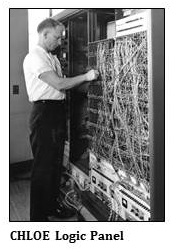
CHLOE was designed to digitize photographic information and perform calculations on the data obtained. Although influenced by its potential application to processing of photographs from high-energy physics spark chamber experiments, the design was intended to be versatile and flexible. Because of this, the system found wide use in a variety of unrelated applications where the only common ground was the use of film as the data storage medium.
The two major system components were an ASI210 computer with paper tape input and output, console typewriter, an auxiliary magnetic tape unit, and an optical scanner unit, designed and built at Argonne, controlled by the computer.
Each of the twin scanning stations consisted of a cathode-ray tube light source, which projected a spot of light onto the film and a photomultiplier to view the light transmitted through the film. The lightspot was driven by a pair of counting registers, so as to appear sequentially at regular points over a designated area of the film frame. The extent of this area and the frequency of the spot’s appearance were determined by the computer program. When the photomultiplier detected a significant change in transmitted light, the coordinates of that point, together with the measured density level were sent to the ASI210 memory. A large display scope was provided to permit operator monitoring of scanning activity.
The ALICE: 1970
CHLOE was retired in 1970 and construction started on the successor system, ALICE, which became operational that year. It consisted of three major components:
- DEC PDP10 computer
- Controller
- Three scanning stations, one for 16mm or 35mm sprocketed film, another limited to 35mm film, and the third accommodating a Leitz Orthoplan Research microscope.
Later, a reflected light scanning station was added. In operation, the Controller’s function specified to the scanning station a series of points (x-y coordinate pairs) at which to measure the density level and dictated the type of information (coordinates, densities, or both) to be recorded, the location in memory at which the data were to be stored, the density levels to be used, end mode of operation for the scanning. Controller action was governed by program setting of 15 parameter registers. Operator facilities included a monitor scope, a conventional CRT display, a 35mm film recorder, a track ball, and an optical display screen with a light pen input facility.
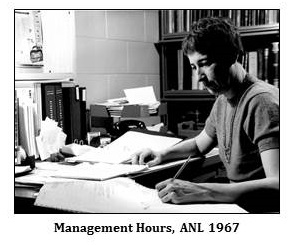
Margaret worked on an image-processing project to automate the analysis of metaphase chromosome images using the CHLOE hardware. In this application, 35mm film photographs of metaphase spreads made at the microscope were scanned and digitized by the CHLOE system with the computer program setting the machine parameters, directing the scan operation, and determining shape characteristics before recording the partially analyzed data on magnetic tape for transfer to a larger computer and further processing.
In the larger computer each chromosome was identified and associated with a point in 7-dimensional space, using the theory of algebraic invariants. A separation distance, or similarity measure, was calculated for all possible pair combinations and a machine karyotype prepared, displayed, and photographed.
A second, reactor, image-processing project undertaken involved the measurement of fragmentation residue filmed in chemical engineering studies of physical and chemical interactions between reactor structural and fuel materials and reactor coolants. In the fragmentation experiments, single drops of materials such as molten tin, lead, bismuth, and uranium dioxide were dropped into reactor coolants such as water and sodium. The degree of fragmentation that ensues was a function of the drop height (entrance velocity) and/or drop size, and the temperatures of the molten metal and the quenching medium. Measures of this fragmentation (e.g. the count of the number of particles, their individual surface areas, and the cumulative particle size distribution) were made using the CHLOE system and a variant of the karyotype software and the information gained utilized in reactor safety heat transfer calculations.
During the 1955 to 1972 period Margaret was responsible for Laboratory computer performance evaluation and computer system enhancement studies undertaken in regard to upgrading the Laboratory’s IBM360/ 50-75system. A two-part benchmark problem collection was developed to simulate the characteristics of the Laboratory’s computing load. One part of the collection consisted of applications problems representative of Argonne’s discipline-oriented research programs and reactor development activities. The other was a sample job stream simulating the current computer system workload.
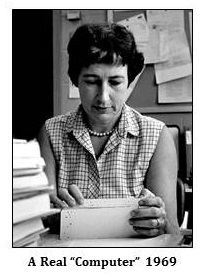
The accounting monitor and a statistics summary program were employed to provide cumulative statistics for almost eight days of ANL System 360 operation in December 1970. Construction of the job stream model centered on reproducing the CPU time distribution of this December sample.
The collection was utilized in conjunction with the 1971-1972 computer acquisition evaluation. Later, when the Neurotron hardware monitor was completed, it was used to collect instruction count statistics and related machine performance data for the applications problems in the ANL benchmark collection.
- These measurements were studied to determine similarity of individual problems, and a Euclidean metric was applied in an attempt to identify job clusters with like attributes.
- The Neurotron hardware monitor system was built around a Varian 620/I minicomputer and a random access memory with associated arithmetic data accumulation hardware.
- The monitoring was done by means of non-interfering probes attached to the host system CPU, channels, and device circuitry to accumulate the counting and timing activity data.
Argonne National Labs 1959-1965
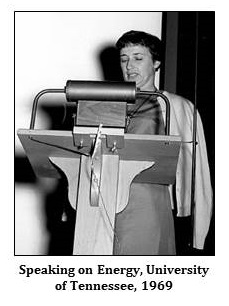
From 1959 to 1965 Margaret served as Head of the Laboratory’s Applications Programming Section in the Applied Mathematics Division, and during this time set up the Argonne Code Center, predecessor of the National Energy Software Center.
During Margaret’s tenure, ANL was one of the U.S. Department of Energy’s national laboratories. It was operated for DOE by the University of Chicago and occupied a site about 27 miles southwest of Chicago. Argonne’s program covered a wide range of energy-related research and development activities including fundamental studies in the physical sciences, reactor, environmental, and life sciences.
On a personal note, Margaret’s husband, Jim Butler, as a staff scientist, also was involved in many ANL projects, particularly GEORGE, the CHLOE image processing projects, and ALICE chromosome images. Jim was not involved in any of her management positions; in fact she “outranked” him, and his reaction was great pleasure and pride!
Their work together provided them a rich life of shared intellectual challenge, travel, and many interesting friends and colleagues from around the US and Europe. Scientists visiting Argonne from Europe looked forward to the many dinner parties Margaret and Jim hosted at their home in a leafy suburb of Chicago. Jim left Argonne around 1969 to do independent consulting for commodity and options trading firms in Chicago. He helped develop the first “real time” commodity price information system, leading to the electronic trading platforms of today.
Margaret quotes Gabriel Okara, a Nigerian journalist who participated in a foreign work study program at Argonne in 1960, who provided a vivid description of the Argonne of the early years. “What are the people like who work at Argonne – the scientists, the engineers, the technicians, the administrative personnel, the cafeteria staff, the drivers and other categories of workers? One thing that would certainly strike the visitor is their extreme friendliness, their desire to help, their informality and comradeship.”
Argonne National Labs 1965-1972
From 1965 until 1972, Margaret also performed computer science research in the history of computers, benchmarking and performance measurement, and image processing.
Director of the National Energy Software Center (formerly Argonne Code Center) 1972- 1991
In 1972 the Argonne Code Center program was broadened from its original reactor orientation to an agency-wide software exchange and information facility, with its scope expanded to cover the entire spectrum of Atomic Energy Commission research and development activities. Margaret became increasingly devoted to the management and operation of the Center over the next few years until it occupied all her time and effort.
The Center’s program was expanded with the transition to the Energy Research and Development (ERDA) administration in 1975 and again in 1977 with the change from ERDA to the Department of Energy. In July of 1978 the Code Center was designated the National Energy Software Center to better reflect the present program and current computer terminology.
The National Energy Software Center (NESC) was the software exchange and information center for the U.S. Department of Energy and the Nuclear Regulatory Commission. Computer programs developed under agency sponsorship are collected, tested, and packaged to make them useful to others and maintained in the Center’s software library to be distributed upon request. Major objectives of the NESC were to promote software sharing among agency programs and contractors, to facilitate the transfer of agency-funded computer applications and technology developed by the agency to others, and to serve as the DOE focal point for transfer of computing technology, software exchange and acquisition.
From 1972-1991, as full-time Director of the NESC, Margaret devoted a significant amount of time and effort to problems of program interchange and portabililty. She participated in the identification and development of standards for computers and information processing as a member of professional society and American National Standards committees.
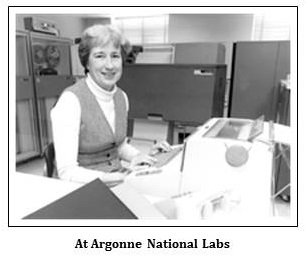
By 1986 the Center had a staff of 11, with a software collection of almost 1400 software packages. Package material consisted generally of the computer-readable elements, such as programming language source and operating system control records, sample problem or test case input and output, associated hard-copy documentation usually in the form of technical reports, user’s manuals, and organizational memoranda. Frequently auxiliary routines and data libraries are included as well.
Most of the software was then written in FORTRAN for the larger computer systems, such as the Cray and Control Data Corporation’s CDC7000 and large Cyber machines, the IBM 30xx series, Digital Equipment Corporation’s VAX hardware, and UNIVAC 1100s. The software was supplied predominantly by the DOE National Laboratories, particularly Argonne, OakRidge, Lawrence Livermore, Los Alamos, Sandia, and the Idaho National Engineering Laboratory.
Margaret’s position gained her an invitation as one of the very first groups of Westerners to visit China, art of a trip to meet with Chinese scientists and discuss the potential sharing of DOE nuclear reactor codes. This was both an honor and an adventure, but she would have greatly preferred not to be so shepherded, and liked to escape the controlled agenda to explore the realities for herself!
Margaret’s role at Argonne remained in computing and computer-related research until her retirement in 1991. At that time, the Center Margaret had begun in 1960 for sharing and distributing software developed with funding from the AEC and its successor organizations, and from the Nuclear Regulatory Commission, was taken over by the Department of Energy.
Women in Technology: A Perspective
“The Second Sex:” Experiences at ANL
A few anecdotes from Margaret on being a woman at the Laboratory ….
“In 1954, when I was pregnant, I thought I would announce the fact by wearing a maternity outfit to work. Much to my astonishment, Dr. Chu managed to overlook the fact, saying that it was wise of me to find an outfit designed to keep me free of chalk dust from the office chalkboard…”
“The Laboratory had no maternity leave policy. When I told them that I intended to take off for 8 weeks and then return to work, no one seemed to hear me. It was assumed I would quit my job. Since it was not permissible to use my sick leave as maternity leave, I asked that I be granted “leave without pay”. This engendered much discussion until it was finally decided that this might be possible, but only if I had a final physical in Health Services, just in case I didn’t return. (I was seeing my own physician on a weekly basis at the time.) I still have, and treasure, the form letter I received following that visit to the ANL doctor. Under ‘Subject: Review of Physical Examination,’ it stated, ‘The data obtained during your recent physical examination at the Health-Service have been reviewed. We are able to report that the examinations conducted revealed … a ‘Condition of which you are aware.’ A gross understatement at the time!”
Much, much less amusing was this information: “In February of 1969, upon employees’ requests, data were provided showing the percentage of women employed at Argonne, by personnel classification. At that time, there were a total of 786 women out of more than 5200 total employees, just 15%, but more significantly, only 49 of those 786 women (6%) were staff members, 158 (21%) were salary-level personnel, and 573, or 73%, were hourly workers.”
And for a scathing indictment of gender discrimination, which was in fact addressed, but late in the game: “In November 1974, a special study of pay levels of all staff and salary-level personnel was conducted to determine if any possible inequities existed in the compensation structure. Result? All women in those positions were found to be undercompensated, and received a raise.”
As a Woman in Technical Management 1957-1972
Margaret was initially introduced to management as the group leader of the Reactor Engineering Division’s Computing Group in 1959.
When this group was merged into the newly-created Applied Mathematics Division, she served successively as Head of the Division’s Applications Programming Section, Director of the Argonne Code Center (forerunner of today’s National Energy Software Center), and member of the Applied Mathematics Division’s Consultation and Research Section. In this last position, she did computer science research in the areas of history of computers, benchmarking and computer performance measurement, and image processing.
In mid-1965, the hobgoblin of Margaret’s lack of advanced degrees, combined with largely pre-feminist societal mores, again cropped up. She had often said that she was given “all of the responsibility but none of the authority.” I am sure many women (and men) can relate to that feeling! But in 1965, she was passed over for promotion. Of course she felt it. Of course, it is virtually impossible to tease out and properly weight the real factors in being passed over (personal or political?) Her reaction was characteristic. Margaret asked to be relieved of her section management responsibility, feeling that since she hadn’t been selected for a higher management position she was blocking those under her from moving into management positions. A high-minded gesture indeed! Especially when accompanied by her continued commitment to the Labs.
She continued in her role as Director of the Argonne Code Center on a half-time basis and spent the remainder of her time as a member of the Consultation and Research Section (later renamed Mathematical Algorithms and Information Science) doing research in the areas of image processing, history of computers, and reactor physics computation.
Public Service and Standards 1972-1991
Later in her career, in the great tradition of technology statesmanship, Margaret increasingly devoted her time to problems of software interchange and portability. As Director of the National Energy Software Center, Margaret’s duties became less technical than previously and more administrative.
She participated in the development of standards for computers and information systems as a member of professional societies and the accredited American National Standards Institute X3 standards committees.
She worried about funding for the Center and tried to understand the lawyers’ pronouncements on intellectual property rights and copyright law which affect our software sharing and technology transfer efforts.
She lamented, “I seem to have come full circle; again, there is no correct answer. Each lawyer may come up with what seems to be a different answer and probably they are all right for their particular cases. Once again, I am frustrated by the lack of quantitative analysis and absolute truth!”
After her formal retirement in 1991, Margaret continued as a special-term appointee at ANL 1993 through 2006. She was also the author of “Careers for Women in Nuclear Science and Technology,” 1992.
Margaret made her home in the greater Chicago area, until her recent death on March 8, 2013, at the age of 89. She will be greatly missed.
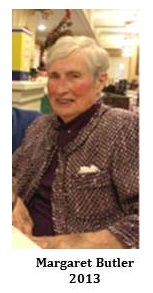
Women as Scientists: Past, Present, and Future
Margaret comments, “Women have played key roles throughout the history of computer science.” Her assessments of women as scientists, in particular those in the computer science and mathematics fields, those she has known and top contenders, follow, in her own words:
• Ada Augusta Lovelace, the only daughter of the English poet Lord Byron, is recognized as the first computer programmer from her work with Charles Babbage in the mid-1800s. The Ada programming language adopted by the Department of Defense is named for her.
• Grace Murray Hopper, Special Advisor to the Commander, Naval Data Automation Command, U.S. Navy, is acknowledged as one of the leaders in the development of a common business programming language during her employment with the UNIVAC Division of Sperry Rand from 1949 to 1967. I personally feel her contributions have been exaggerated by history….my key personal memory is of her smoking and drinking in the ladies loo!
• Jean Sammet, Manager of Programming Language Technology at IBM, has contributed significantly to the use of computers for non-numerical mathematics, served as Vice-President and President of the oldest professional society in computer science, the Association for Computing Machinery, from 1972 to 1976, and is a Member of the National Academy of Engineering.
• Personally, I learned programming at Argonne from Jean Hall, who was one of the many women ‘computers’ who developed programs for the first electronic computer, the ENIAC, which began operation in 1946.
• The first woman I met who held a true decision-making position at the Lab was Hoylande Young, Director of the Technical Information group at its inception. She told me that when the AEC was attempting to establish Site D, she was assigned the job of talking to officials of neighboring towns and villages to assure them that the rumors that a “bomb factory” was to be constructed at the Du Page site were not true! Dr. Young, a former college Chemistry professor, remained the only female Laboratory Division Director for many years.
• When I, along with others in the AEC laboratories, commuted to New York University to use the UNIVAC, I met Phyllis Fox, who moved to Bell Laboratories in New Jersey, where she had the responsibility for the development of mathematical subroutine libraries for numerical computation. The fact that most human “computers” were women gave them a head start in the emerging discipline of computer science.
• In Mathematics, my favorite woman is Emmy Noether. She also became the only woman on IBM’s “Men of Modern Mathematics” chart!
• Ruth Davis, later President of her own consulting firm in Washington, previously served as Deputy Undersecretary of Defense for Research and Engineering in the Department of Defense and as Assistant Secretary of Energy in the Department of Energy.
• Catherine Morawetz headed the famous Courant Institute of Mathematical Sciences at New York University.
• In Statistics, one of the most well-known women is Elizabeth Scott, Professor of Statistics at the University of California, Berkeley, who was President of the Institute of Mathematical Statistics in 1977-78 and is a Fellow of the Royal Statistical Society.
Advice for Young Women Scientists
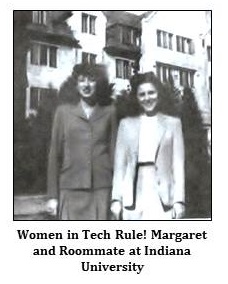
Margaret’s advice for anyone with an interest in a science or technology career:
[LIST=1]
Thoughts on Colleagues, Thoughts on Women
Margaret comments, “During my years at Argonne I have enjoyed the excitement of working at the forefront of both the atomic age and the computer revolution.”
“I have had the opportunity to meet and talk with famous scientists and engineers such as Enrico Fermi, Richard Courant, John von Neumann, and Maria Mayer, and to work with intelligent, interesting, and caring colleagues with fantastic resources at our disposal.”
She states, “Perhaps the only change I’d like to make, if I had my career to live over again, would be to have a larger proportion of women scientists and engineers in the Argonne population. I don’t believe the number is any larger now than it was when I first arrived 46 years ago.”
The truth is, women are historically vastly underrepresented in STEM (Science, Technology, Engineering and Math) fields, and this is still very true, even today. Hence, women in these fields face special challenges.
- 1945 marks the very first year that women were allowed to graduate from Columbia Engineering School.
- In 1986, about one-third of Argonne’s 3170 employees were scientists and engineers. Approximately 110 of the scientists and engineers were women. These 110 represented just 3.5% of Argonne’s total employment, and 14% of the institution’s 784 female employees.
- A 2011 report by the U.S. Department of Commerce found:
- Only one in seven engineers is female.
- Today, women hold only 27% of all computer science jobs, and that number isn’t growing.
- Although women fill 48% of all jobs in the U.S. economy, they hold less than 25% of STEM jobs. This has been the case throughout the past decade.
- About 25% of bachelor’s degrees awarded to men are in STEM fields, compared with 10%conferred on women; these shares have remained about the same between 1998 and 2008.
- About 66% of STEM degrees awarded to men were in engineering and computer science, compared with 25% awarded to women.
Margaret said in 1986, and it still holds true, “My assessment is that we have yet to attain a critical mass in the scientific and engineering fields, and until then women will have to work harder and smarter…they are not yet judged as individuals, but as a class, and profit or lose based on the actions of females who precede them.”
As a female technologist myself, I am happy and grateful to acknowledge a great debt to Margaret Butler and many like her, who have delivered valuable contributions, who have paved the way for us, and who have helped create more recognition and opportunities for women in the fields of science and technology.
References
1. “SCIENCE CAREERS IN SEARCH OF WOMEN,” CAREER OPTIONS IN THE SCIENCES, Mathematics, Computing, and Management, May 18, 1990, by Margaret Butler.
2. “39 YEARS OF COMPUTING,” a talk by Margaret Butler.
3. “ORAL HISTORIES OF WOMEN SCIENTISTS,” a talk at William Rainey Harper College, March 5, 1986, by Margaret Butler.
4. “WESTERN SPRINGS ROTARY TALK,” a presentation August 9, 2005, by Margaret Butler.
5. “Women in STEM: A Gender Gap to Innovation,” August 2011, U.S. Department of Commerce, http://www.esa.doc.gov/Reports/women-stem-gender-gap-innovation
6. Personal correspondence and interviews with Margaret Butler, Sept 2010-April 2011 and Feb 2013; with Holly Stump.
7. Personal correspondence with Jay W. Butler and Cheryl Stein, February and March, 2013.
8. Also see “Top Secret Rosies: The Female Computers of WWII,” a film narrated by LeAnn Erickson.
Copyright 2013, Margaret Butler and Holly Stump
Share this post via:






Jensen Huang Drops Donald Trump Truth Bomb on Joe Rogan Podcast